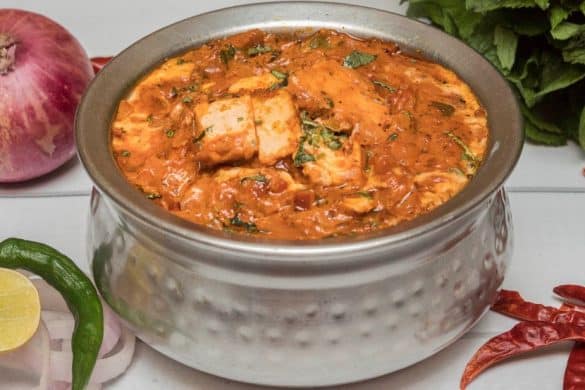Mughal Biryani is a delightful and aromatic rice dish that originated during the Mughal era in India. This exquisite recipe combines tender mutton, fragrant basmati rice, and a blend of spices to create a flavorful and indulgent meal. The dish is known for its rich flavours and the perfect balance of spices, making it a favourite among biryani lovers.
The mutton is marinated with ginger, garlic paste and salt to prepare Mughal Biryani, ensuring that each piece is infused with delicious flavours. The onions, tomatoes, and ginger garlic paste are sautéed to create a fragrant base. Combining spices, including red chilli powder and coriander powder, adds a delightful kick to the dish.
Adding ground almond paste and coconut milk gives the biryani a creamy and nutty flavour, elevating it to a new level. The basmati rice is cooked separately and layered with partially cooked mutton and spices. The dish is then cooked on low heat, allowing the flavours to meld together and the rice to absorb all the aromatic goodness.
Mughal Biryani is a complete meal and is often served with onion raita, which adds a refreshing contrast to the rich and flavorful biryani. This dish is perfect for special occasions, family gatherings, or when you want to taste Mughal royalty.

Mughal Biryani

Mughal Biryani
Ingredients
- 1 kg Mutton chopped
- 1 kg Basmati Rice
- 1 cup Curd
- 6 Onions chopped
- 6 Tomatoes chopped
- 100 g Ginger Garlic Paste
- 3 tsp Red Chilli Powder
- 4 tsp Coriander Powder
- 4 Green Chillies slit
- 100 g Cashewnuts soaked in water for a few minutes
- 25 g Almonds soaked in water for a few minutes
- 3 cups Coconut Milk
- Salt as per taste
- Oil as required
- A small piece of Cinnamon
- 1 Clove
- 1 Bay Leaf
Instructions
- Grind the soaked cashew nuts and almonds to a fine paste.
- add the mutton pieces and half of the ginger garlic paste in a bowl. Mix well and season with salt.
- Heat oil in a pan and fry the Cinnamon, clove, and bay leaf for 30 seconds.
- Add the chopped onions, tomatoes, and the remaining ginger garlic paste to the pan. Sauté for 2 minutes until the onions turn golden brown.
- Sprinkle salt, red chilli powder, coriander powder, and slit green chillies into the pan. Mix well.
- Add the ground almond paste and coconut milk to the pan. Stir until well combined.
- Pour enough water into the pan and bring it to a boil.
- Wash the basmati rice thoroughly and add it to the pan with the partially cooked mutton pieces. Mix gently.
- Cover the pan with a lid and simmer over low heat for 10 to 15 minutes, allowing the rice to cook and the flavours to meld together.
- Remove the pan from the heat Once the rice is cooked and the mutton pieces are tender.
- Serve the hot and aromatic Mughal Biryani with onion raita for a complete and satisfying meal.
Sign up for our newsletter
Frequently Asked Questions (FAQs):
How can I make the Mughal Biryani more flavorful?
To enhance the flavour of Mughal Biryani, you can add a pinch of saffron strands soaked in warm milk to the rice before layering it with the partially cooked mutton. This will impart a lovely aroma and a hint of luxuriousness to the dish.
Can I substitute chicken for mutton in this recipe?
Yes, you can easily substitute mutton with chicken in this recipe to make a delicious Mughal Chicken Biryani. The cooking time may vary, so ensure the chicken is cooked thoroughly before layering it with the rice.
What are some suitable pairings for Mughal Biryani?
Mughal Biryani pairs well with refreshing mint chutney, cucumber raita, or mixed vegetable curry. For a complete Mughlai feast, you can also serve it alongside flavorful dishes like Chicken Korma or Shahi Paneer.
Can I make Mughal Biryani with leftover rice?
While it is traditionally made with fresh basmati rice, you can use leftover cooked rice to make Mughal Biryani. Ensure the rice is warm and fluffed before layering it with the partially cooked mutton.
Is Mughal Biryani a spicy dish?
Mughal Biryani has a mild to medium level of spiciness, depending on your preference. You can adjust the amount of red chilli powder and green chillies according to your taste to make it milder or spicier.









